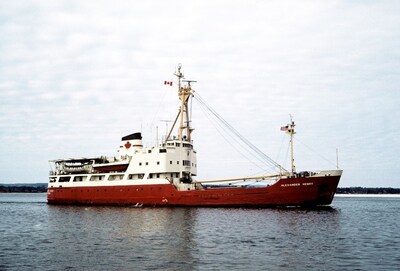The former Canadian Coast Guard Ship (CCGS) Alexander Henry is a retired light icebreaker, buoy tender, and navigational aid ship that served on the Great Lakes from 1959 to 1985
THUNDER BAY, ON, July 20, 2024 /CNW/ – Alexander Henry is permanently moored in Thunder Bay, Ontario, on Lake Superior. It is a retired light icebreaker, buoy tender and navigational aid ship that served as the first Canadian government-owned icebreaker on the Great Lakes, from 1959 to 1985. Constructed in the former Port Arthur Shipyard in 1958 for the Department of Transport’s Marine Services fleet, the ship was one of 49 large vessels incorporated into the Canadian Coast Guard upon the agency’s inception in 1962.
Today, the Honourable Patty Hajdu, Minister of Indigenous Services and Member of Parliament for Thunder Bay–Superior North, commemorated the national historic significance of CCGS Alexander Henry with a special ceremony to unveil a plaque at the Marina Park in Thunder Bay. The announcement was made on behalf of the Minister of Environment and Climate Change and Minister responsible for Parks Canada, Steven Guilbeault.
The ship is a well-preserved example of the shipbuilding program of the era, embodying the government’s commitment to marine navigation through icebreaking, lighthouse supply, buoy maintenance, and search and rescue mission support. The ship was officially retired in 1985 and has since served as a museum ship in Kingston and Thunder Bay, where it is now owned and operated by the Lakehead Transportation Museum Society. Alexander Henry has been an exceptional educational tool to inform communities and members of the public about the history of the Canadian Coast Guard and the critical work it continues to do throughout Canadian waters.
Alexander Henry is part of a long history of government support for marine navigation. It is symbolic of the increase in industrial shipping activities and commerce on the Great Lakes in the second half of the 20th century.
The Government of Canada, through the Historic Sites and Monuments Board of Canada, recognizes significant people, places, and events that shaped our country as one way of helping Canadians connect with their past. The designation process under Parks Canada’s National Program of Historical Commemoration is largely driven by public nominations. To date, more than 2,240 designations have been made nationwide.
National historic designations illustrate the defining moments in the story of Canada. Together, they tell the stories of who we are and connect us to our past, enriching our understanding of ourselves, each other, and our country. Heritage places provide a wide range of cultural, social, economic, and environmental benefits to their communities.
Quote
“Today, on Canadian Coast Guard Day, the Government of Canada is proud to unveil the official Historic Sites and Monuments Board of Canada plaque honouring the legacy of the CCGS Alexander Henry. This retired icebreaker symbolizes Canada’s commitment to maritime safety and the impressive heritage of the Canadian Coast Guard. As a well-preserved relic, this amazing vessel continues to educate and inspire, showcasing Canada’s rich maritime history and our continued dedication to preserve our nation’s heritage for future generations. Congratulations to the Transportation Museum of Thunder Bay and everyone who played a part in acquiring and preserving the CCGS Alexander Henry for the region to enjoy.”
The Honourable Patty Hajdu,
Minister of Indigenous Services, Minister responsible for the Federal Economic Development Agency for Northern Ontario and Member of Parliament for Thunder Bay–Superior North
Quick Facts
- The CCGS Alexander Henry was responsible for the safe navigation of huge volumes of shipping enabled by the construction of canals and locks, culminating in the St. Lawrence Seaway in 1959, which allowed full-sized ocean bulk carriers to travel the Upper St. Lawrence River and to all five of the Great Lakes.
- Alexander Henry was also used to extend the shipping season as long as possible, breaking channels in the ice on Lake Superior during the freeze-up in early winter and around break-up in the spring.
- The vessel is one of the best surviving examples of the government’s icebreaker construction program of the late 1950s, designed to meet Canada’s responsibilities off its coasts and on inland waters.
- Created in 1919, the Historic Sites and Monuments Board of Canada advises the Minister of Environment and Climate Change regarding the national significance of persons, places, and events that have marked Canada’s history. Together with Parks Canada, the Board ensures that subjects of national historic significance are recognized under Parks Canada’s National Program of Historical Commemoration and these important stories are shared with Canadians.
Associated Document
Backgrounder: CCGS Alexander Henry National Historic Site
Related Links
Parks Canada
Historic Sites and Monuments Board of Canada
Framework for History and Commemoration
SOURCE Parks Canada (HQ)

Featured image: ©



